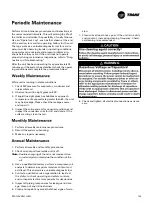
-
Trane believes that responsible refrigerant practices are
important to the environment, our customers, and the
air conditioning industry. All technicians who handle
refrigerants must be properly quali
fi
ed. All local and
international regulations in what handling, reclaiming,
recovering and recycling, must be followed.
R134a is a medium pressure refrigerant. It may not be
used in any condition that would cause the chiller to
operate in a vacuum without a purge system. RTAG is
not equipped with a purge system. Therefore, the RTAG
chiller may not be operated in a condition that would
result in a saturated condition in the chiller of -26°C or
lower.
-
-
The compressor is a semi-hermetic, direct-drive rotary
type compressor. Each compressor has only four moving
parts: two rotors that provide compression and male and
female load-control valves. The male rotor is attached
to the motor and the female rotor is driven by the male
rotor.The rotors and motor are supported by bearings.
The helical rotary compressor is a positive displace-
ment device. Refrigerant vapor from the evaporator is
drawn into the suction opening of the compressor (state
1b), through a suction strainer screen across the motor
(which provides motor cooling) and into the intake of
the compressor rotors. The gas is then compressed and
discharged through a check valve and into the discharge
line (state 2).
There is no physical contact between the rotors and the
compressor housing.The rotors contact each other at
the point where the driving action between the male and
female rotors occurs. Oil is injected into the rotors of
the compressor, coating the rotors and the compressor
housing interior. Although this oil does provide rotor
lubrication, its primary purpose is to seal the clearance
spaces between the rotors and compressor housing.
A positive seal between these internal parts enhances
compressor ef
fi
ciency by limiting leakage between the
high pressure and low pressure cavities. dictated by the
position of the loading valve relative to the rotors. When
the valve slides toward the discharge end of the rotors
compressor capacity is reduced.
RTAG high ef
fi
ciency units and extra ef
fi
ciency units
apply
fi
xed speed compressor, which capacity control
is accomplished by means of a female step load-control
valve and a male control valve. The female step valve is
the
fi
rst stage of loading after the compressor starts and
the last stage of unloading before the compressor shuts
down. The male control valve is positioned by a piston
cylinder along the length of the male rotor. Compressor
capacity is dictated by the position of the loading valve
relative to the rotors. When the valve slides toward the
discharge end of the rotors compressor capacity is re-
duced.
For premium seasonal ef
fi
ciency unit apply varied speed
compressor, capacity control is combined action of slide
valve and variable frequency driver.
Figure 62
, each compressor has an interior replaceable
core oil
fi
lter. It can remove the impurity which may
block the check valve or oil channel of oil, to avoid the
excessive wear of rotors and bearing.
Some RTAG unit has economizer, its compressor has a
gas inlet at female rotor compression chamber , where
refrigerant gas from economizer is inhaled. Compressor
with economizer inlet is shown below.
Operating Principles
Figure 61. Pressure Enthalpy (P-h) diagram of RTAG
with Economizer
RTAG-SVX001H-EN
97
Figure 61
show the refrigerant cycle of pressure enthal-
py diagram of RTAG with economizer unit. Comparing
to figure57, the leaving condenser refrigerant (states 5)
don’t enter EXV, which is separated into two parts. The
minor parts pass through minor EXV (states 5-6), enters
brazed plates heat exchanger economizer, evaporating
in economizer (states 6-7), the superheated refrigerant
gas entering compressor auxiliary port (states 7). The
major parts of refrigerant leaving condenser also enter
economizer and be cooled again (states 5-3b), the super
cooled major refrigerant go through EXV (states 3b-4),
enters evaporator (4-1).
















































